Home / Blog / Marketing & Branding Advice / What Is Typography and Why Does It Matter in Design?
What Is Typography and Why Does It Matter in Design?
Date posted: 15th September 2025 in Marketing & Branding Advice
Last updated: 15th September 2025

Typography isn’t just about picking a font; it’s about shaping how people feel when they interact with your brand. From the curve of a letter to the spacing between words, typography can influence whether someone trusts your business, remembers your message, or even takes action. For businesses, especially in B2B marketing, getting typography right is essential to creating branded merchandise that feels consistent and professional.
The Psychology of Typography
Studies have shown that typography plays a significant role in shaping perception. For example, research published in The Journal of Consumer Psychology found that typefaces can change how people judge credibility and reliability. Serif fonts (like Times New Roman) are often seen as more traditional and trustworthy, while sans-serif fonts (like Helvetica) convey modernity and simplicity. That’s why something as simple as your logo on a promotional mug can create a lasting impression depending on the font style used.
Design Impacts You Might Not Expect
Typography also affects readability and emotional response. A study by Wichita State University revealed that people read sans-serif fonts on screens faster than serif fonts, while print often favors serif fonts for longer texts. Meanwhile, MIT research showed that good typography improves comprehension by up to 20%. This means the font you choose for custom tote bags, branded pens, or corporate apparel can impact how quickly and clearly your message is absorbed.
Beyond Fonts: Layout and Consistency
It’s not just the typeface itself that matters, layout, hierarchy, and consistency all play a role. For example, keeping your headlines bold and uniform across different platforms builds familiarity, while using consistent fonts across your event giveaways and corporate stationery helps reinforce brand recognition. Inconsistent typography, on the other hand, can confuse customers and weaken your professional image.
Typography in Everyday Branding
Think about how many branded items your clients and employees interact with every day. From a branded water bottle on a desk to custom notebooks used in meetings, typography is always front and centre. The clearer and more distinctive your fonts, the more likely people are to recall your brand at a glance. In many ways, typography is the silent salesperson working behind the scenes, keeping your business visible and memorable.
Fun Facts About Fonts
-
Comic Sans, often mocked, was originally designed for comic book-style speech bubbles, yet it remains one of the most recognisable fonts worldwide.
-
NASA’s space shuttle manuals used Helvetica, chosen for its clean, easy-to-read structure under pressure.
-
A study from Princeton University found that harder-to-read fonts can actually improve memory retention, a principle sometimes used in education.
-
The world’s most expensive typeface is “JHA Bodoni Ritalic,” which sold for thousands of dollars due to its exclusivity.
Bringing It Back to Branding
For companies, typography isn’t just a design decision, it’s a branding strategy. Whether you’re printing your name on custom notebooks, water bottles, or trade show giveaways, the font you choose communicates just as much as the color or logo itself. Bold, modern typography tells your audience you’re innovative. Elegant, serif-driven fonts reinforce heritage and reliability. The design impacts of typography ripple across every branded item, shaping how your partners, clients, and customers perceive your business.
Summary: Typography’s Role in Branding
Typography is a vital element of brand identity that goes far beyond aesthetics. It influences readability, emotion, and credibility, making it a key factor in how your business is perceived.
Key takeaways:
-
Typography shapes how audiences judge trustworthiness and style.
-
Good fonts and layouts improve readability and even comprehension.
-
Consistent typography strengthens recognition across all branded items.
-
Every custom product, from mugs to apparel, carries your brand message through font choice.

Strengthen your brand perception with promotional products
Chat online or call us today on 1800-586-1615
More Articles

5 Signs It's Time for New Promo
16th December 2024 in Marketing & Branding Advice

5 Statistics That Prove Promotional Merchandise Actually Works.
24th January 2023 in Marketing & Branding Advice



